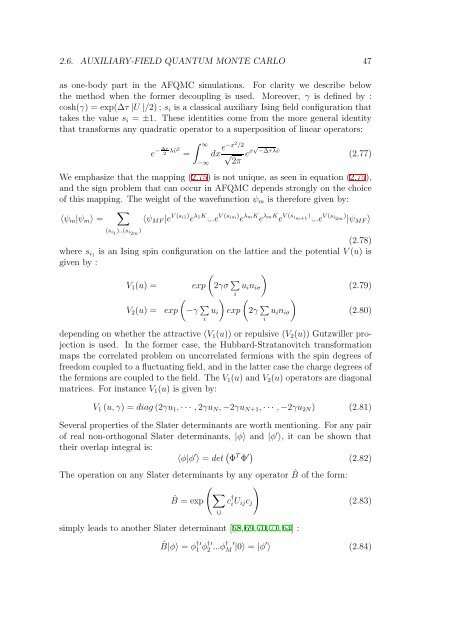pdf, 9 MiB - Infoscience - EPFL
pdf, 9 MiB - Infoscience - EPFL
pdf, 9 MiB - Infoscience - EPFL
You also want an ePaper? Increase the reach of your titles
YUMPU automatically turns print PDFs into web optimized ePapers that Google loves.
2.6. AUXILIARY-FIELD QUANTUM MONTE CARLO 47<br />
as one-body part in the AFQMC simulations. For clarity we describe below<br />
the method when the former decoupling is used. Moreover, γ is defined by :<br />
cosh(γ) =exp(∆τ |U |/2) ; s i is a classical auxiliary Ising field configuration that<br />
takes the value s i = ±1. These identities come from the more general identity<br />
that transforms any quadratic operator to a superposition of linear operators:<br />
e − ∆τ<br />
2 λˆυ2 =<br />
∫ ∞<br />
−∞<br />
dx e−x2 /2<br />
√<br />
2π<br />
e x√ −∆τλˆυ<br />
(2.77)<br />
We emphasize that the mapping (2.75) is not unique, as seen in equation (2.75),<br />
and the sign problem that can occur in AFQMC depends strongly on the choice<br />
of this mapping. The weight of the wavefunction ψ m is therefore given by:<br />
〈ψ m |ψ m 〉 = ∑<br />
〈ψ MF |e V (si1) e λ1K ...e V (sim) e λmK e λmK e V (s i ) m+1 ...e V (s i ) 2m |ψ MF 〉<br />
(s i1 )..(s i2m )<br />
(2.78)<br />
where s i1 is an Ising spin configuration on the lattice and the potential V (u) is<br />
given by :<br />
(<br />
V 1 (u) = exp 2γσ ∑ )<br />
u i n iσ (2.79)<br />
i<br />
(<br />
V 2 (u) = exp −γ ∑ ) (<br />
u i exp 2γ ∑ )<br />
u i n iσ (2.80)<br />
i<br />
i<br />
depending on whether the attractive (V 1 (u)) or repulsive (V 2 (u)) Gutzwiller projection<br />
is used. In the former case, the Hubbard-Stratanovitch transformation<br />
maps the correlated problem on uncorrelated fermions with the spin degrees of<br />
freedom coupled to a fluctuating field, and in the latter case the charge degrees of<br />
the fermions are coupled to the field. The V 1 (u) andV 2 (u) operators are diagonal<br />
matrices. For instance V 1 (u) isgivenby:<br />
V 1 (u, γ) =diag (2γu 1 , ··· , 2γu N , −2γu N+1 , ··· , −2γu 2N ) (2.81)<br />
Several properties of the Slater determinants are worth mentioning. For any pair<br />
of real non-orthogonal Slater determinants, |φ〉 and |φ ′ 〉,itcanbeshownthat<br />
their overlap integral is:<br />
〈φ|φ ′ 〉 = det ( Φ T Φ ′) (2.82)<br />
The operation on any Slater determinants by any operator ˆB of the form:<br />
( )<br />
∑<br />
ˆB =exp c † i U ijc j (2.83)<br />
ij<br />
simply leads to another Slater determinant [68, 69, 70, 71, 64] :<br />
ˆB|φ〉 = φ † 1 ′ φ † 2 ′ ...φ † ′ M<br />
|0〉 = |φ ′ 〉 (2.84)
















